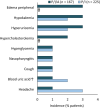Perindopril/Indapamide/Amlodipine in Hypertension: A Profile of Its Use
- PMID: 35257306
- PMCID: PMC8964631
- DOI: 10.1007/s40256-022-00521-0
Perindopril/Indapamide/Amlodipine in Hypertension: A Profile of Its Use
Erratum in
-
Correction to: Perindopril/Indapamide/Amlodipine in Hypertension: A Profile of Its Use.Am J Cardiovasc Drugs. 2022 May;22(3):355. doi: 10.1007/s40256-022-00535-8. Am J Cardiovasc Drugs. 2022. PMID: 35352322 Free PMC article. No abstract available.
Abstract
The single-pill combination (SPC) of perindopril (PER)/indapamide (IND)/amlodipine (AML) is a valuable and convenient treatment option for patients with hypertension controlled with two-drug SPC of PER/IND + AML given as two separate pills at the same dose level. PER [an angiotensin-converting enzyme (ACE) inhibitor], IND (a thiazide-like diuretic) and AML (a calcium channel blocker) are well established antihypertensive agents, which have been available for a long time as monotherapies and dual SPCs and have complementary mechanisms of action. Once-daily PER/IND/AML provided effective BP control, with good tolerability, in patients with uncontrolled hypertension in clinical trials and in large observational prospective studies. The efficacy and tolerability of PER/IND/AML was similar to that of PER/IND + AML in a randomized clinical trial. The therapeutic effect of PER/IND/AML was associated with improved health-related quality of life. Thus, switching from the two-pill PER/IND + AML regimen to single-pill PER/IND/AML reduces pill burden and simplifies drug administration, which may improve adherence to treatment, leading to better BP control and clinical outcomes.
Plain language summary
Approximately one-quarter of patients with hypertension require three antihypertensive agents to achieve BP control. However, complex treatment regimens and high pill burden reduce treatment adherence, which in turn leads to poor BP control. Perindopril (PER), indapamide (IND), amlodipine (AML) belong to the core drug classes for the treatment of hypertension. These drugs have been available for a long time as monotherapies and two-drug single-pill combinations. Once-daily PER/IND/AML provides very good BP control in patients with uncontrolled hypertension and is generally well tolerated. The single-pill PER/IND/AML has similar efficacy and tolerability to PER/IND + AML given as two separate pills. Therefore, switching from PER/IND + AML to PER/IND/AML reduces pill burden and simplifies the treatment regimen, which may improve adherence to treatment, leading to better BP control and clinical outcomes. Thus, PER/IND/AML is a valuable and convenient treatment option for patients with hypertension controlled with PER/IND + AML at the same dose level.
© 2022. The Author(s), under exclusive licence to Springer Nature Switzerland AG.
Conflict of interest statement
Yahiya Y. Syed is a salaried employee of Adis International Ltd/Springer Nature, and declares no relevant conflicts of interest. All authors contributed to the review and are responsible for the article content.
Figures


Similar articles
-
Adherence to Triple Single-Pill Combination of Perindopril/Indapamide/Amlodipine: Findings from Real-World Analysis in Italy.Adv Ther. 2023 Apr;40(4):1765-1772. doi: 10.1007/s12325-023-02451-y. Epub 2023 Feb 24. Adv Ther. 2023. PMID: 36829102 Free PMC article.
-
Single-Pill Combination of Perindopril/Indapamide/Amlodipine in Patients with Uncontrolled Hypertension: A Randomized Controlled Trial.Cardiol Ther. 2017 Jun;6(1):91-104. doi: 10.1007/s40119-017-0085-7. Epub 2017 Feb 8. Cardiol Ther. 2017. PMID: 28181192 Free PMC article.
-
Efficacy and safety of a single-pill versus free combination of perindopril/indapamide/amlodipine: a multicenter, randomized, double-blind study in Chinese patients with hypertension.J Hypertens. 2024 Aug 1;42(8):1373-1381. doi: 10.1097/HJH.0000000000003741. Epub 2024 Apr 24. J Hypertens. 2024. PMID: 38660708 Free PMC article. Clinical Trial.
-
The role of single-pill ACE inhibitor/ccb combination for hypertension: an Algerian view via the nominal group technique.Future Cardiol. 2025 Mar;21(3):155-166. doi: 10.1080/14796678.2025.2465218. Epub 2025 Feb 12. Future Cardiol. 2025. PMID: 39943810 Free PMC article. Review.
-
Efficacy of Single-Pill, Triple Antihypertensive Therapy in Patients with Uncontrolled Hypertension: A Systematic Review and Meta-analysis.High Blood Press Cardiovasc Prev. 2022 May;29(3):245-252. doi: 10.1007/s40292-022-00511-y. Epub 2022 Mar 24. High Blood Press Cardiovasc Prev. 2022. PMID: 35325410
Cited by
-
A real-world analysis of outcomes and healthcare costs of patients on perindopril/indapamide/amlodipine single-pill vs. multiple-pill combination in Italy.J Hypertens. 2024 Jan 1;42(1):136-142. doi: 10.1097/HJH.0000000000003570. Epub 2023 Sep 19. J Hypertens. 2024. PMID: 37728093 Free PMC article.
-
Transforming growth factor-β1 and vascular endothelial growth factor levels in senile acute myeloid leukemia and correlation with prognosis.World J Clin Cases. 2024 Jul 16;12(20):4121-4129. doi: 10.12998/wjcc.v12.i20.4121. World J Clin Cases. 2024. PMID: 39015902 Free PMC article.
-
A Rapid, Sensitive, and High-throughput Method for the Simultaneous Determination of Antihypertensive Drug Combinations in Dog Plasma by UHPLC-MS/MS: The Assessment of Predicable Bioequivalence of In-vitro Dissolution Condition.Curr Pharm Des. 2024;30(32):2574-2585. doi: 10.2174/0113816128295265240613061905. Curr Pharm Des. 2024. PMID: 38956914
-
Stage-dependent proteomic alterations in aqueous humor of diabetic retinopathy patients based on data-independent acquisition and parallel reaction monitoring.J Transl Med. 2025 Apr 25;23(1):476. doi: 10.1186/s12967-025-06452-z. J Transl Med. 2025. PMID: 40281624 Free PMC article.
-
SkeletAge: Transcriptomics-based Aging Clock Identifies 26 New Targets in Skeletal Muscle Aging.bioRxiv [Preprint]. 2025 Jul 31:2025.07.28.667277. doi: 10.1101/2025.07.28.667277. bioRxiv. 2025. PMID: 40766611 Free PMC article. Preprint.
References
-
- Neutel JM, Smith DH. Hypertension management: rationale for triple therapy based on mechanisms of action. Cardiovasc Ther. 2013;31(5):251–258. - PubMed
-
- Williams B, Mancia G, Spiering W, et al. 2018 ESC/ESH Guidelines for the management of arterial hypertension. Eur Heart J. 2018;39(33):3021–3104. - PubMed
-
- National Institute for Health and Care Excellence. Hypertension in adults: diagnosis and management. NICE guideline [NG136]. 2019. https://www.nice.org.uk/guidance/ng136. Accessed 14 Sep 2021.
Publication types
MeSH terms
Substances
LinkOut - more resources
Full Text Sources
Medical
Miscellaneous

